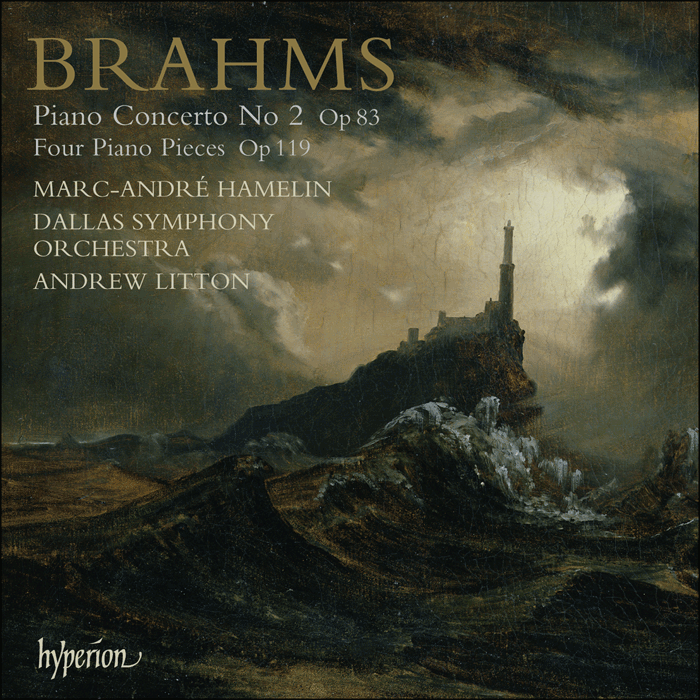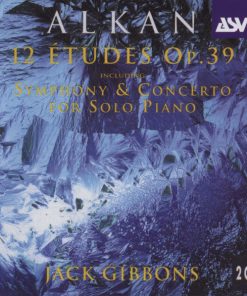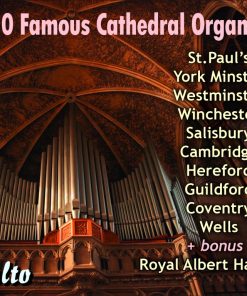Brahms: Piano Concerto No 2, Klavierstucke, Op. 119 – Marc-André Hamelin, Dallas Symphony Orchestra, Andrew Litton Hyperion
$ 20,99 $ 12,59

Piano Concerto No 2 in B flat major Op 83[46’02]
1
Allegro non troppo[17’04]
2
Allegro appassionato[8’44]
3
Andante[11’27]
4
Allegretto grazioso[8’47]
Clavierstücke Op 119[15’20]
5
No 1 in B minor: Intermezzo[4’22]
6
No 2 in E minor: Intermezzo[4’35]
7
No 3 in C major: Intermezzo[1’23]
8
No 4 in E flat major: Rhapsodie[5’00]

Hyperion’s Record of the Month for August features Marc-André Hamelin and the Dallas Symphony Orchestra under Andrew Litton in a compelling account of Brahms’s huge Piano Concerto No 2. This work blends the principles of symphony and concerto in a manner that invokes chamber music, while also representing the culmination of everything that Brahms had learned as a lifelong connoisseur of pianistic technique. Cast in four large movements, this concerto can be seen as a kind of pianistic autobiography, from the young virtuoso, through the D minor anguish of the scherzo and the self-communing chamber-like slow movement, to the Hungarian rhythms of the more ebullient song-and-dance finale. The Four Piano Pieces Op 119 written in the composer’s final years—three ravishingly inward and autumnal Intermezzi offset by a virile and heroic Rhapsodie—complete this rounded portrait of the composer.
Marc-André Hamelin’s pianistic authority and, when required, thrilling virtuosity are underpinned by a deep understanding of this epic work. He is magnificently partnered by the Dallas Symphony Orchestra and Andrew Litton, and his intimate dialogue with the solo cello in the slow movement is a high-point of this richly fulfilling interpretation. Marc-André’s musicianship is further revealed in his poignant and searching performance of the four late solo pieces. For lovers of this composer, and of great piano-playing, this is essential listening.
Fast Shipping and Professional Packing
Due to our longstanding partnership with UPS FedEx DHL and other leading international carriers, we are able to provide a range of shipping options. Our warehouse staff are highly trained to pack your goods exactly according to the specifications that we supply. Your goods will undergo a thorough examination and will be safely packaged prior to being sent out. Everyday we deliver hundreds of packages to our customers from all over the world. This is an indication of our dedication to being the largest online retailer worldwide. Warehouses and distribution centers can be located in Europe as well as the USA.
Orders with more than 1 item are assigned processing periods for each item.
Before shipment, all ordered products will be thoroughly inspected. Today, most orders will be shipped within 48 hours. The estimated delivery time is between 3-7 days.
Returns
The stock is constantly changing. It's not entirely managed by us since we are involved with multiple parties such as the factory and our storage. The actual stock can fluctuate at any time. Please understand it may happen that your order will be out of stock when the order is placed.
Our policy is valid for 30 days. If you haven't received your product within 30 days, we're not able to issue either a return or exchange.
You are able to return a product if it is unused and in the same condition when you received it. It must also still remain in the original packaging.
Related products
MUSIC CD
MUSIC CD




















































